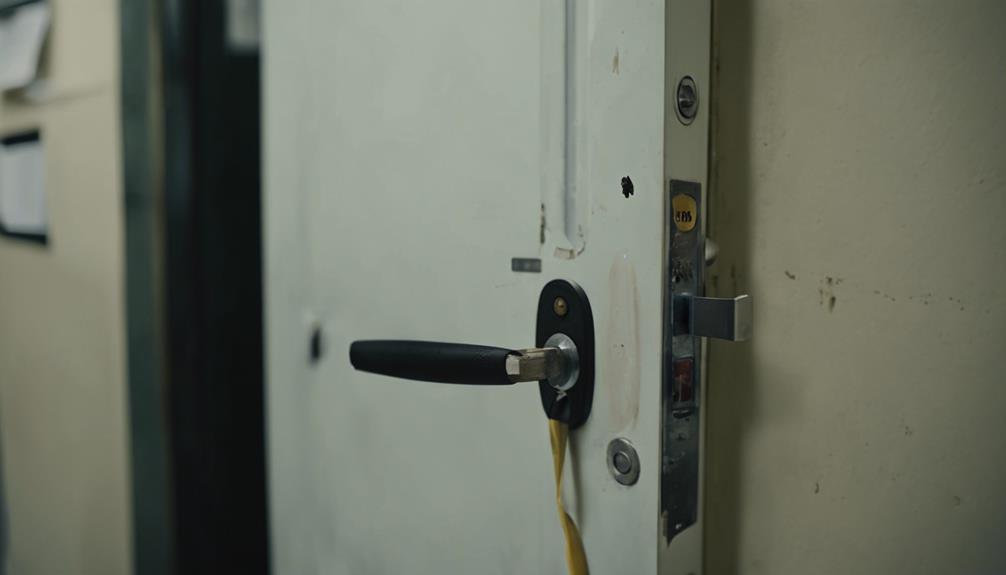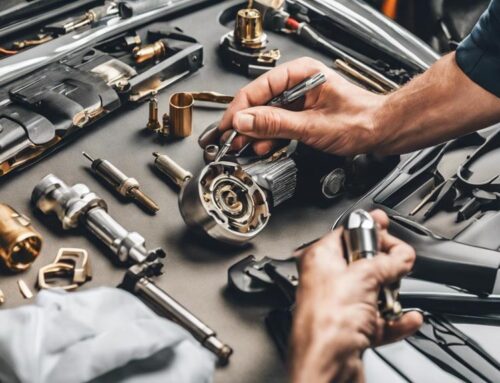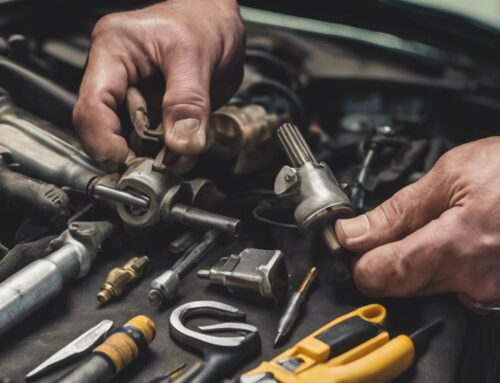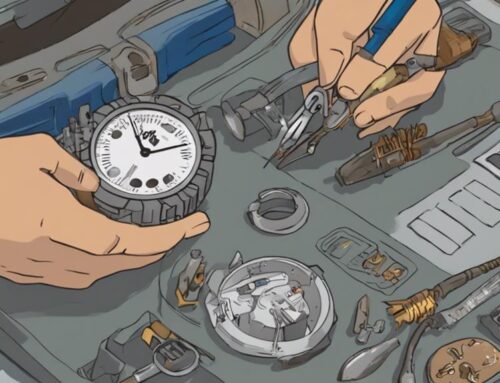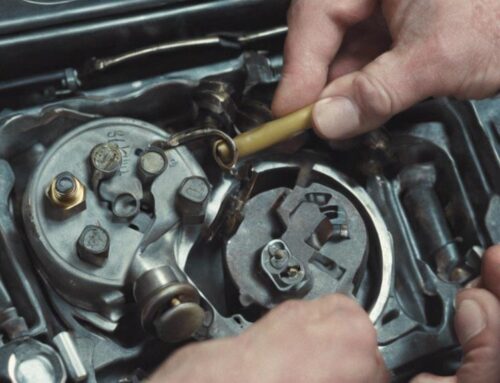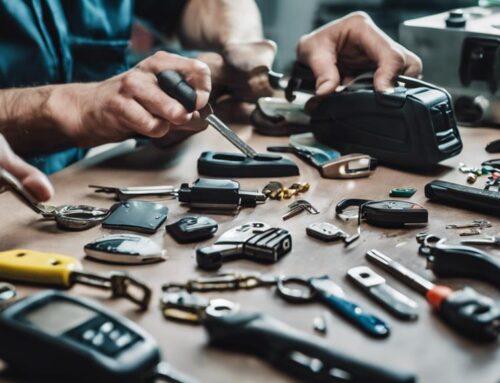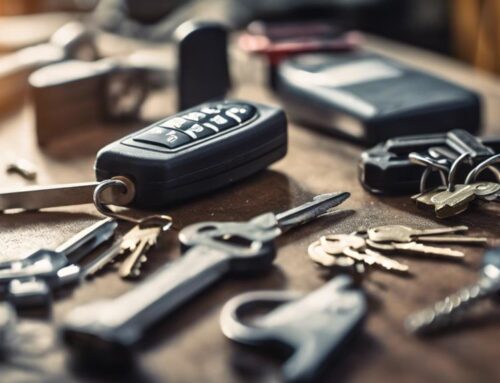In commercial buildings, you might encounter a range of lock repair issues that can disrupt operations, from worn-out keys to sticky locks and misaligned door frames. It's vital to recognize these common problems to prevent costly repairs and enhance security. Regular maintenance and proper installation can greatly mitigate these issues, but understanding the root causes is just as important. What steps can you take to guarantee your locking systems remain reliable and efficient? Exploring preventive measures can help you maintain peace of mind and protect your assets effectively.
Key Takeaways
- Regularly inspect locks for wear and tear at least quarterly to identify issues early and prevent costly repairs.
- Lubricate locks and hinges annually with high-quality lubricant to ensure smooth operation and prevent rust.
- Choose heavy-duty locks for high traffic areas to withstand frequent use and reduce wear and tear.
- Implement a key management policy to track keys and limit duplicates, minimizing the risk of frequent key loss.
- Ensure qualified technicians perform lock installations to guarantee proper alignment and security effectiveness.
Worn Out Keys
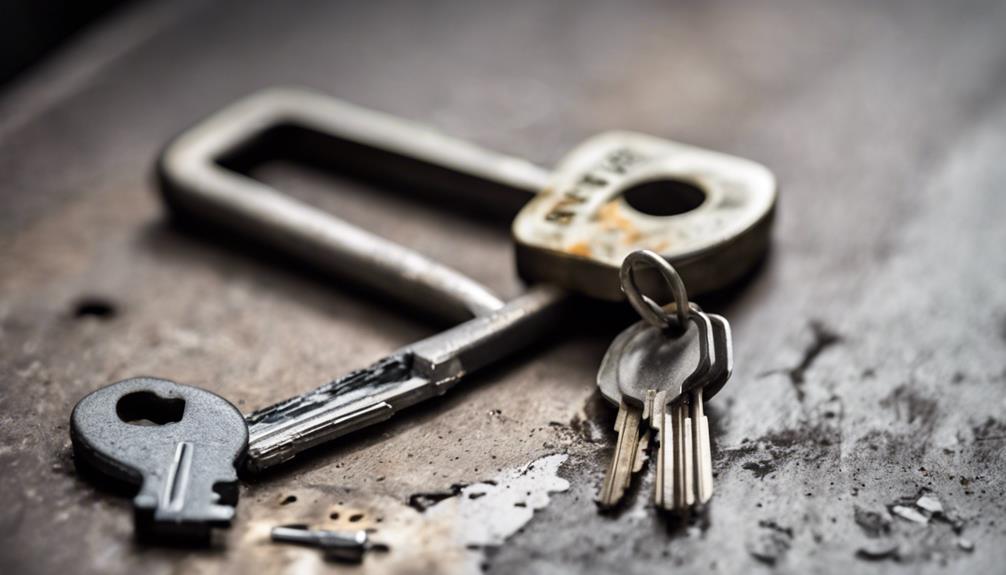
Worn out keys can greatly hinder access in commercial buildings, leading to frustration for employees and visitors alike. When faced with this issue, you've got key replacement options that are vital for maintaining security and functionality. Consider rekeying existing locks or opting for complete lock replacements for a more secure solution. Additionally, employing advanced key duplication techniques can guarantee that you have reliable backups available, minimizing downtime. Regularly evaluating the condition of your keys can help you identify wear before it becomes a considerable problem. Keeping a stock of spare keys and utilizing high-quality materials in key production will enhance durability. By acting proactively, you can considerably reduce the risk of access issues and maintain operational efficiency in your facility. It's essential to recognize that rekeying locks is also recommended after certain events, such as employee departure or key loss, to enhance security measures.
Sticky Locks
Sticky locks can greatly impede access in commercial buildings, causing delays and frustration among users. The primary culprit behind sticky locks is often the lack of proper lock lubrication. Over time, dust, grime, and moisture can accumulate, leading to malfunction. Regularly applying a high-quality lubricant can markedly enhance the smoothness of the lock mechanism, guaranteeing efficient operation. Additionally, verify that your keys are properly duplicated when needed; worn or improperly cut keys can also contribute to lock stickiness. By maintaining your locks and investing in quality key duplication, you'll prevent sticky locks, thereby enhancing accessibility and security in your commercial space. Regular inspections and maintenance can keep your locks functioning effectively and avoid unnecessary disruptions.
Maintaining a regular lock maintenance program, as highlighted in Essential Lock Maintenance for Business Security, can also help prevent sticky locks and guarantee the overall security of your commercial building.
Misaligned Door Frames
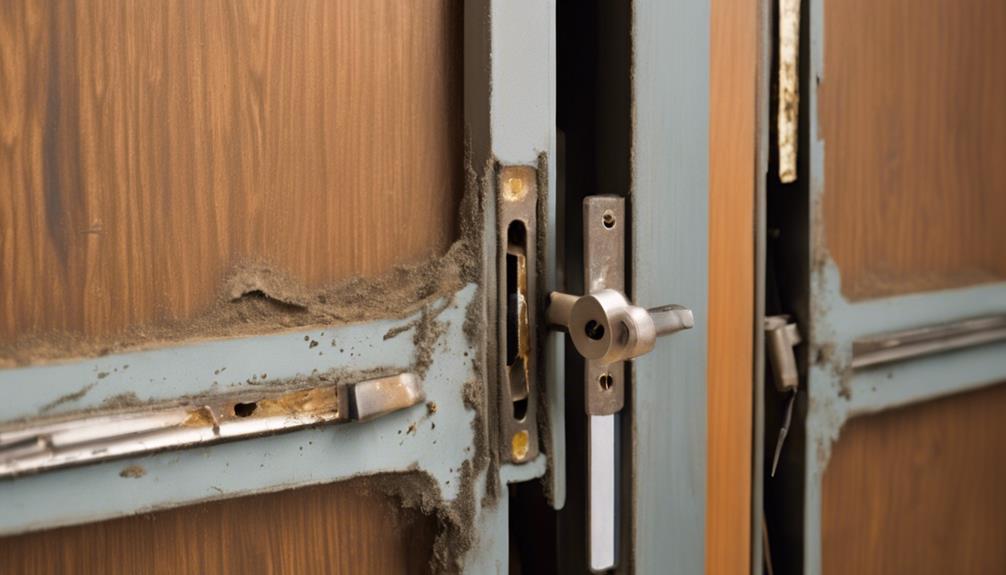
Misaligned door frames can lead to a range of lock-related issues, affecting security and accessibility. You'll want to recognize the common causes and signs of misalignment to address these problems promptly. Implementing preventive maintenance strategies can help you maintain proper door alignment and prolong the lifespan of your locking mechanisms.
Causes of Misalignment
In commercial buildings, the alignment of door frames can be compromised by various factors, leading to significant locking issues. Understanding these causes is essential for maintaining security and functionality. Here are three main contributors to misalignment:
- Door Hinge Issues: Worn or improperly installed hinges can cause doors to sag, impacting frame alignment. If left unaddressed, this can lead to further damage and compromise the security of the building.
- Environmental Factors: Temperature fluctuations and humidity can cause building materials to expand or contract, shifting door frames out of alignment.
- Structural Settling: Over time, a building may settle unevenly, leading to misaligned door frames that affect locking mechanisms.
Signs of Misaligned Frames
How can you tell if your door frames are misaligned? First, check for gaps between the door and the frame; uneven spacing is a clear indicator of door alignment issues. Next, observe how easily the door opens and closes. If you notice sticking or dragging, it suggests improper frame adjustments. Inspect the hinges as well; if they're loose or misaligned, this can exacerbate the problem. Additionally, look for visible warping in the frame itself, which can lead to further complications. Finally, listen for unusual noises when operating the door; creaking or grinding could signal deeper alignment problems. Addressing these signs promptly can prevent more extensive repairs, safeguarding your building's integrity and functionality.
Preventive Maintenance Tips
Regular preventive maintenance can greatly reduce the risk of misaligned door frames in commercial buildings. By implementing a structured approach, you can guarantee that your doors function at their best. Consider the following preventive measures:
- Conduct routine inspections: Regularly assess door frames for signs of misalignment. Early detection can save time and costs. Additionally, understanding the rekeying process for business locks can help in maintaining security (Understanding the Rekeying Process for Business Locks).
- Perform routine lubrication: Keep hinges and locking mechanisms well-lubricated to prevent stiffness and misalignment over time.
- Adjust door hardware: Periodically check screws and brackets to verify they're secure, preventing shifting that can lead to misalignment.
Broken Lock Mechanisms
Broken lock mechanisms can greatly impact the security and functionality of your commercial building. You might notice signs of malfunctioning locks, such as difficulty turning the key or unusual noises during operation. Understanding the causes of lock breakage, such as wear and tear from frequent use or exposure to harsh weather conditions, and implementing proper maintenance tips can help extend the lifespan of your locks. Consider investing in routine inspections and lock lubrication to prevent lock failures and guarantee the security of your premises.
Causes of Lock Breakage
Locks can fail for a variety of reasons, often stemming from mechanical wear and tear or environmental factors. Understanding these causes is essential for enhancing lock durability and preventing future issues. Here are three primary causes of lock breakage:
- Poor Key Material: Using low-quality or damaged keys can lead to excessive strain on the lock mechanism, causing premature failure.
- Environmental Stress: Extreme temperatures, moisture, or exposure to corrosive substances can weaken lock components and lead to breakdowns.
- Inadequate Maintenance: Neglecting regular lubrication and inspections can result in dirt buildup and mechanical failure.
Signs of Malfunctioning Locks
Identifying the signs of malfunctioning locks is essential for maintaining security in commercial buildings. Pay attention to inconsistent lock performance, such as difficulty in turning the key or a lock that feels loose. If you notice any unusual noises when locking or opening, it's a clear indication of internal issues. Additionally, if the lock fails to engage or disengage properly, it's time for a security assessment. Look for signs of physical damage, like dents or scratches, which can compromise the lock's integrity. Regularly monitoring these indicators can prevent further issues and potential security breaches. Addressing these concerns promptly guarantees your commercial environment remains secure and operational. Remember that understanding lock repair costs and time for offices can help you plan and budget effectively for maintenance Understanding Lock Repair Costs and Time for Offices.
Maintenance Tips for Longevity
To keep your lock mechanisms in top shape, it's crucial to stay on top of regular maintenance. Neglecting these practices can lead to costly repairs and security breaches. Follow these critical tips for longevity:
- Perform regular inspections: Check locks at least quarterly to identify wear and tear before it escalates into a malfunction. It's also important to choose the right locks for your business maintenance program, such as electronic and high-security locks (Choosing the Right Locks for Your Business Maintenance Program).
- Apply lock lubrication: Use a high-quality lubricant annually to guarantee smooth operation and prevent rust or jamming.
- Replace worn components: Don't hesitate to replace any damaged parts immediately to maintain the integrity of your locks.
Corroded Lock Components
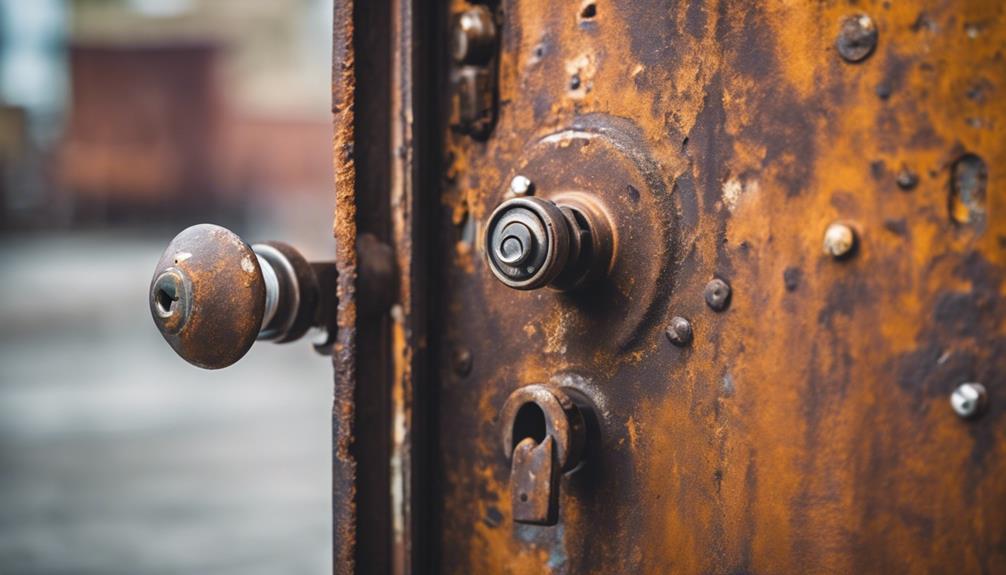
Corroded lock components can greatly compromise the security and functionality of commercial buildings. To safeguard your assets, implement effective rust prevention measures. Start by selecting high-quality locks made from corrosion-resistant materials, such as stainless steel or brass. Additionally, moisture control is critical; guarantee proper drainage around entrances and maintain humidity levels within the building. Regularly inspect locks for signs of corrosion, and address any issues immediately to prevent escalation. Applying a protective lubricant can also minimize the risk of rust formation. By proactively managing these factors, you'll enhance the durability of your locking systems and maintain a secure environment. Remember, a small investment in maintenance today can save you from costly repairs tomorrow. For more insights on commercial lock maintenance costs and tips, understand Commercial Lock Maintenance Costs and Tips.
Improper Installation
Improper installation of locks often stems from inadequate techniques and a lack of adherence to industry standards. When you choose qualified technicians, you guarantee that locks are installed correctly, minimizing potential security risks. It's essential to understand that even small mistakes during installation can lead to significant issues down the line.
Installation Techniques and Standards
When installing locks in commercial buildings, cutting corners can lead to significant security problems down the line. Adhering to proper installation techniques and standards is essential. Here are three key factors to take into account:
- Lock Alignment: Make certain that locks are perfectly aligned with the strike plate to prevent wear and tear.
- Installation Standards: Follow industry guidelines to assure that locks function effectively and meet security codes.
- Hardware Quality: Use high-quality materials that withstand frequent use and resist tampering.
Choosing Qualified Technicians
Selecting qualified technicians for lock installation is essential to guarantee security and functionality in commercial buildings. To achieve this, you must verify certification requirements, ensuring technicians possess the necessary credentials for commercial lock systems. Look for professionals who have undergone rigorous training and hold certifications from recognized organizations, which indicates their commitment to industry standards. When choosing technicians, consider their experience and background in commercial installations. Seasoned experts often anticipate potential issues before they arise, enhancing the reliability of your locking mechanisms. Opting for professionals with a successful track record in installations minimizes the risk of improper installation and future repairs. Your choice of technician is a critical investment in your building's security.
Frequent Key Loss
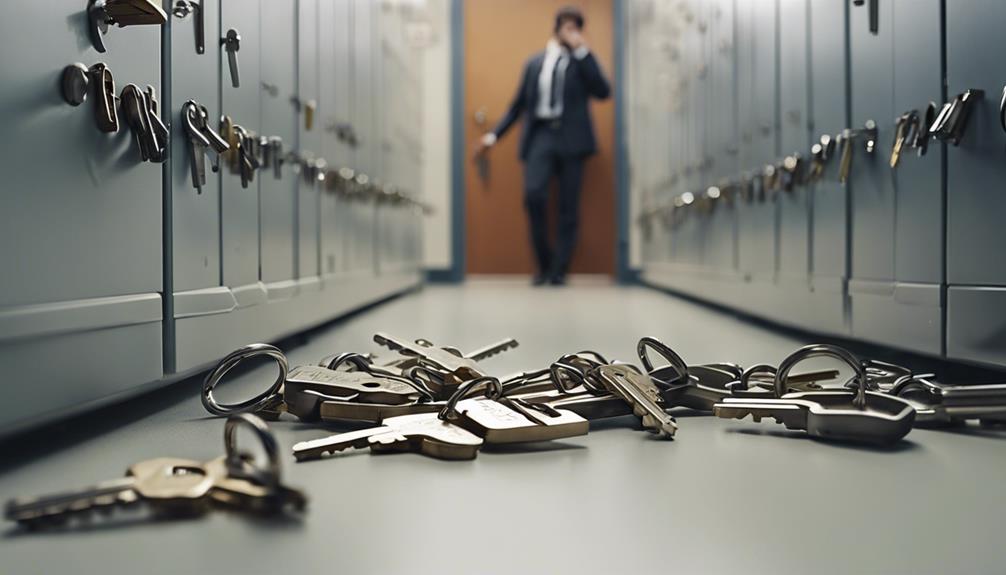
Frequent key loss can disrupt the daily operations of commercial buildings, leading to security vulnerabilities and increased costs. To mitigate these risks, effective key management is essential. Here are three strategies to contemplate:
- Implement a Key Tracking System: Use a digital platform to monitor key distribution and usage. This guarantees accountability and helps you identify patterns of loss.
- Limit Duplicate Keys: Only authorize duplicates when absolutely necessary. Too many copies can increase the likelihood of loss.
- Educate Employees: Conduct training sessions to emphasize the importance of key security. Make sure everyone understands the potential consequences of key loss.
High Traffic Wear and Tear
High traffic areas in commercial buildings often experience significant wear and tear on locks, leading to potential security risks and operational inefficiencies. To mitigate these issues, focus on lock durability by selecting high-quality, heavy-duty locks specifically engineered for high-use environments. Regular maintenance is essential; inspect locks frequently for signs of damage or malfunction. Implement effective traffic management strategies to reduce excessive strain on locks, such as staggered employee entry times and designated access points. By proactively addressing wear and tear, you can enhance the longevity of your locking systems and maintain a secure, efficient operation. Investing in durable locks and instituting proper management protocols guarantees that you safeguard your assets while minimizing repair costs.
Security System Failures
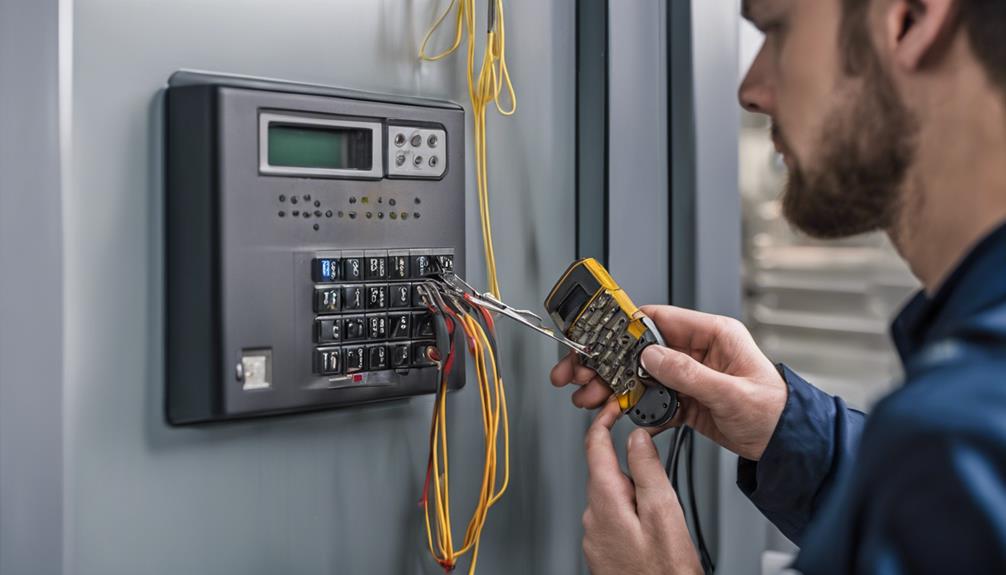
Security system failures can occasionally occur in commercial buildings, posing significant risks to safety and operations. Understanding the common causes can empower you to take preventive measures. Here are three critical issues to address:
- Access Control System Malfunctions: Regularly test and update your access control systems to guarantee they function correctly.
- Outdated Security Upgrades: Stay informed about the latest security technologies and implement necessary upgrades to mitigate vulnerabilities.
- Inadequate System Integration: Ascertain that all components of your security systems work seamlessly together to avoid potential failures.
Importance of Professional Services
Regularly engaging professional services for lock repairs in commercial buildings is essential for maintaining safety and operational efficiency. By leveraging expert insights, you gain access to the latest techniques and technologies that enhance security measures. Professional services not only guarantee compliance with industry standards but also provide service advantages like timely repairs and preventative maintenance, reducing long-term costs. Their specialized knowledge allows them to quickly identify underlying issues that may not be apparent to untrained eyes. This proactive approach minimizes downtime and potential security breaches, ultimately safeguarding your assets. Relying on professionals enables you to focus on core business operations, knowing your security needs are in capable hands. Empower your business by prioritizing expert lock repair services.

